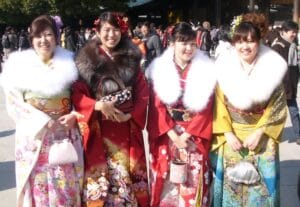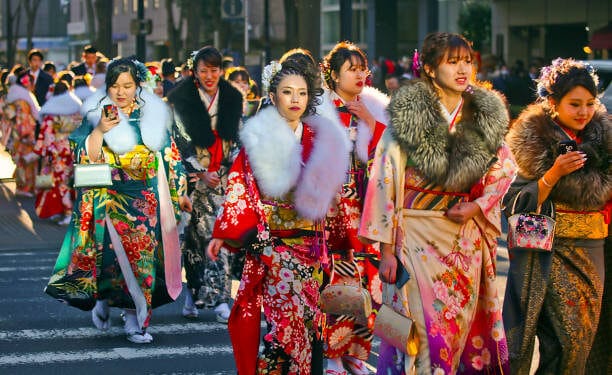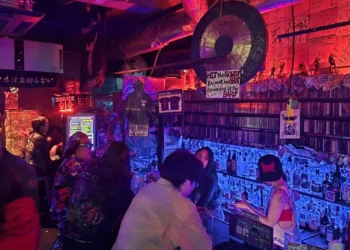No products in the cart.
Coming of Age Day in Japan: A Celebration of Adulthood and Tradition
Introduction
In Japan, the transition from adolescence to adulthood is marked by an important cultural milestone known as Coming of Age Day (成人の日, Seijin no Hi). This national holiday, celebrated annually on the second Monday of January, honors young adults who have reached or will reach the age of 20 within the current academic year. Turning 20 in Japan signifies reaching legal adulthood, bringing new rights and responsibilities, such as voting, drinking alcohol, and signing contracts.
This blog explores the significance of Coming of Age Day, its historical roots, modern-day celebrations, and the cultural values it embodies.
The Origins of Coming of Age Day
Coming of Age Day has its roots in ancient Japanese traditions. During the Nara period (710–794), ceremonies known as *genpuku* were held to mark the transition of boys from childhood to adulthood. Similarly, *mogi* ceremonies signified the coming of age for girls in noble families. These rituals involved donning adult attire and hairstyles as a symbolic step into maturity.
The modern version of Coming of Age Day was established in 1948 as a national holiday, reflecting Japan’s post-war emphasis on rebuilding its cultural identity. Initially celebrated on January 15, the holiday was moved to the second Monday of January in 2000 as part of the “Happy Monday System,” which created long weekends to promote tourism and leisure.
What Happens on Coming of Age Day?
Ceremonial Events: Seijin-shiki
The highlight of Coming of Age Day is the *seijin-shiki* (成人式), or coming-of-age ceremony, held by local municipalities across Japan. These ceremonies are typically hosted in community centers or city halls, where newly recognized adults gather to celebrate their milestone.
During the ceremony, local officials deliver speeches, offering congratulations and advice for the young adults as they step into adulthood. Participants also receive small commemorative gifts, such as certificates, souvenirs, or vouchers.
Traditional Attire: Furisode and Hakama
A key feature of Coming of Age Day is the elaborate attire worn by participants. Women often wear *furisode*, a formal type of kimono with long, flowing sleeves, symbolizing youth and unmarried status. These kimonos are brightly colored and intricately patterned, showcasing Japan’s rich textile artistry.
Men, on the other hand, may wear *hakama* paired with a *haori* jacket or opt for Western-style suits. The choice between traditional and modern attire reflects the blending of old and new in Japanese culture.
Cultural Significance of Turning 20 in Japan
Turning 20 in Japan is more than just a birthday; it marks a legal and societal transformation. At this age, individuals gain full adult rights and responsibilities, including:
– The right to vote in elections.
– Legal permission to consume alcohol and smoke.
– Eligibility to sign contracts independently.
This transition embodies the values of independence, responsibility, and civic engagement, which are central to Japanese society.

Modern-Day Celebrations and Trends
Photo Shoots and Preparations
In the lead-up to Coming of Age Day, many young adults participate in professional photo shoots, often with their families. These sessions capture the significance of the occasion, with participants dressed in their ceremonial attire.
Social Media and Sharing
In recent years, social media has added a new dimension to Coming of Age Day. Many young adults share their experiences, outfits, and celebrations online, creating a digital archive of this important life event.
Regional Variations
While the essence of Coming of Age Day remains consistent, regional variations add unique flavors to the celebration. For example:
– In Okinawa, ceremonies may include traditional Ryukyuan attire.
– In colder regions like Hokkaido, participants may wear warm overcoats over their kimonos.
Challenges and Criticisms
Despite its cultural significance, Coming of Age Day faces challenges in modern Japan.
Rising Costs
The cost of participating in Coming of Age Day can be prohibitive, particularly for women. Renting or purchasing a furisode can range from ¥100,000 to ¥500,000 (approximately $700 to $3,500 USD), and additional expenses include hairstyling, makeup, and accessories. This has led some families to seek more affordable alternatives or forego the event altogether.
Declining Participation
Japan’s declining birth rate and rural depopulation have impacted the scale of Coming of Age Day celebrations. In smaller towns, ceremonies are becoming less frequent, with some municipalities merging events or holding them for multiple age groups.
The Role of Coming of Age Day in Preserving Tradition
Coming of Age Day serves as a bridge between Japan’s past and present, preserving traditional customs while adapting to modern realities. The holiday reinforces cultural values such as respect for community, the importance of family, and gratitude for one’s upbringing.
Moreover, it offers a rare opportunity for young adults to reconnect with childhood friends and reflect on their journeys. For many, the day is not just about reaching adulthood but also about expressing gratitude to the people who supported them along the way.
Real-Life Stories: Voices of New Adults
A Participant’s Perspective
Yumi, a 20-year-old from Tokyo, shared her experience:
“Wearing a furisode was a dream come true. It felt like a rite of passage, and I was proud to celebrate with my family and friends. The ceremony reminded me of my responsibilities as an adult, but it was also a lot of fun.”
A Parent’s Reflection
Mr. Tanaka, a father from Osaka, reflected on his daughter’s coming-of-age ceremony:
“It was emotional to see my daughter in her kimono. It made me realize how quickly time flies. The day was a mix of pride, nostalgia, and excitement for her future.”
Planning Your Coming of Age Day Experience
If you’re a foreign resident in Japan or planning to experience the holiday, here are some tips:
1. Attend a Local Ceremony: Check with your city hall for details about participating in a seijin-shiki.
2. Explore Kimono Rentals: Many rental shops offer packages, including hairstyling and photography.
3. Capture the Moment: Don’t forget to document your experience through photos or videos.
Conclusion: Celebrating Adulthood in Japan
Coming of Age Day in Japan transcends the concept of a simple holiday; it serves as a deeply meaningful cultural tradition that highlights the transition to adulthood. Rooted in history and rich with symbolism, this occasion embodies the core values and customs that shape Japanese society, offering a moment to honor growth, responsibility, and connection.











[b]Your absolute command[/b] over dynamic functional device – [u]you’re a driver, a flyer along with a discoverer![/u]
[b]Tweak and improve[/b] model to suit you – [u]master, study, discover your surroundings as you please![/u]
[b]Get unforgettable delight[/b] and unique thrills – [u]due to your victories plus outcomes![/u]
[url=https://psee.io/7dcler][b]Click here to get[/b][/url] awesome model that your pal is missing [u]right now![/u]
[url=https://psee.io/7fxb3x][img]https://tripacostarica.com/1/tr/1.png[/img][/url]
[b]Summer this year[/b] provides amazing opportunities for budget-conscious travelers chasing unforgettable experiences without emptying the bank.
To optimize value, check out destinations and strategies that combine affordability with adventure.
Eastern Europe, like Poland or Hungary, is a jewel—vibrant cities like Krakow or Budapest deliver rich history, stunning architecture, and delicious cuisine at a slice of Western Europe’s costs.
[url=https://psee.io/7fxb3x][img]https://tripacostarica.com/1/tr/2.png[/img][/url]
[b]Hostels and Airbnb[/b] rentals begin at $20–$30 per night, and hearty meals cost under $10. Southeast Asia, including Vietnam and Thailand, persists a top pick for tropical vibes.
Picture Hanoi’s bustling markets or Chiang Mai’s serene temples, with street food at $1–$3 and guesthouses around $15.
[url=https://psee.io/7fxb3x][img]https://tripacostarica.com/1/tr/3.png[/img][/url]
[b]For North Americans[/b], Mexico’s Riviera Maya fuses pristine beaches with cultural sites like Tulum, where all-inclusive deals launch at $80/night.
Lock in flights early, use fare alerts, and select for public transport to save. Traveling off-peak (June or late August) trims costs further.
With savvy planning, your summer trip can be both affordable and incredible!
[url=https://psee.io/7fxb3x][b][u]Get your value-for-money travel right now![/u][/b][/url]
[b]Make new[/b] pills for massive peaks – bigger also additional vivid peaks!
[b]Never observed[/b] earlier – highly most within clinical science study!
[b]Entirely risk-free[/b] plus powerful – likewise boosted drive also still elevated erectile rigidity!
[url=https://psee.io/7qlgd7][b]Increase size of individual ejaculations right right now![/b][/url]
[u][b]We are rushing into their help[/b][/u]—some group with technicians who can quickly repair this effects of one drainage disaster in thy home!
[u][b]Your fast action[/b][/u] – some secret for decreasing thy outlays for all following large repairs!
[url=https://5.gp/b31q6i3y][b]Test our pace plus quality by service right now![/b][/url]
Groundbreaking fresh supplements designed for powerful ecstasies – more intense combined with even more powerful experiences!
Unique discovery – leading-edge breakthroughs in scientific field!
Completely risk-free and highly effective – boosts passion combined with strengthens sexual rigidity!
[url=https://psee.io/7qlgd7][b]Maximize one’s ejaculation load now![/b][/url]
[u]We’re prepared to fix the situation[/u] — a skilled team set to handle your plumbing problem and return peace in your residence!
[u]Our rapid assistance aids in[/u] – decrease the demand for costly serious overhauls down the line.
[u]Explore our prompt and superior[/u] work – immediately!
[b]USA – tel.: 8338561951[/b]
[b]Full Throttle Summer Savings Event![/b]
[b]Summer’s are just discounts[/b] – on swag and drones [b]DJI[/b], [b]GEPRC[/b], [b]RadioMaster[/b], [b]Ethix[/b], [b]TBS[/b], [b]Lumenier[/b], [b]Flywoo[/b], [b]EMAX[/b] and won’t now it’s!
[url=https://psee.io/7zu6yq][b]GetFPV’s Full Throttle Summer Savings event is on![/b][/url]
[url=https://psee.io/82nbtf][img]https://tripacostarica.com/1/tr/4.png[/img][/url]
[u][b]Inexpensive[/b][/u] trip near to abode!
[u][b]Balmy[/b][/u] beaches, gentle waters, together deep!
[u][b]Affordable prices![/b][/u]
Whole those shall make one’s coast [b][u]retreat indelible![/u][/b]
[url=https://psee.io/82nbtf][b]Schedule personal pass to bliss right now![/b][/url]
[u][b]Water Damage Mitigation Service[/b][/u] targets upon aiding inhabitants swiftly dealing with moisture-connected matters.
[b][u]Service’s principal goal[/u][/b] acts as in order to stop more damage, maintain redeemable possessions, and restore protection for an abode.
[b][u]This kind of help[/u][/b] is commonly needed following events including plumbing leaks, torrential precipitation, inundation, hurricanes, plus different natural catastrophes permitting let water into infiltrate residential zones.
[b][u]Envision an circumstance[/u][/b] wherein one line ruptures or one deluge engulfs one residence, damaging boundaries, immersing upholstery, plus potentially breeding mold unless neglected.
[u][b]Swift action[/b][/u] proves essential regarding minimise harms furthermore contain increasing fix outlays. Within the ways will the service aid?
[u][b]Our crew come[/b][/u] swiftly to pump out extra water, fully desiccate those affected regions, and guard property property versus infestation growth or else extra degradation.
[u][b]Ultimately[/b][/u], that procedure steadies such home furthermore confirms property’s occupancy post an incident . Our help omits comprehensive rebuilding however prepares the basis for upcoming upgrades simultaneously averting increased acute problems later the future.
[b][u]Get our help right now – 8338561951[/u][/b]
[b]Own realize[/b] how intimidating that seems when water causes yours dwelling and relatives’ convenience under danger.
[b]Yet[/b] you stay never alone.
[b]We have been[/b] here so as to protect one’s home together with the comfort relating to your household day-to-day, performing deliberately plus safely so that all yourself value remains unbroken.
[b]That[/b] group acts swiftly toward block damage as well as avert spores, granting one tranquility from consciousness.
[b]Also[/b] with our all-day service, someone perpetually get somebody beside the side — set to guide you keep your loved ones protected plus one’s property enriched through ease.
[b]Find peace in your home[/b] – [u]Call: 8338561951[/u]
[b]Personally understand[/b] the manner alarming the situation comes across when flood sets their house along with kin’s well-being at danger.
[b]Nevertheless[/b] you are not alone.
[b]We’re[/b] ready to defend the house along with such coziness from your family lifestyle, operating carefully and soundly so everything one love continues secure.
[b]Our[/b] staff functions promptly toward cease devastation as well as stop growth, bringing you relief belonging to thought.
[b]In addition[/b] backed by such always-on help, yourself forever maintain someone next to yours presence — prepared to help somebody keep the relatives guarded plus yours residence full by security.
[b]Find peace in your home[/b] – [u]Call: 8338561951[/u]
[url=https://www.tripacostarica.com/hiking-trails-near-me/][img]https://tripacostarica.com/1/Hiking-trails-near-me.png[/img][/url]
[b]Explore[/b] the hidden beauty just waiting right around our steps.
Hiking routes near your town bring much more than workouts—they act as a retreat into Earth’s silence.
[b]Take in[/b] pure the fresh air,
stroll twisting routes along trees plus mountains,
and discover magical scenes meant to transform one walk worthwhile.
[b]Regardless if[/b] you could be looking for excitement,
balance in life,
or a great picture location,
local ways deliver this adventure alive.
[b]Tie[/b] the footwear—your upcoming exploration is just closer than you believe.
[b][url=https://www.tripacostarica.com/hiking-trails-near-me/]Hiking trails near you[/url][/b]
[b]Visualize[/b] coming home to find moisture soaking into the rooms, belongings, and family treasures.
[b]It’s devastating[/b] — but you are never left alone.
[b]We’re here to preserve[/b] your family’s home and peace, responding fast and gently to limit harm before it spreads. Our team works with care and safety, restoring not just your property but also your peace of mind.
[b]We help you[/b] avoid mildew and hidden damage, protecting the comfort of your home. And with our 24/7 support, you’re always supported through emergencies — we’re just a call away!
[b][u]Call – 8338561951 and professionals will help you![/u][/b]
[b]me[/b] comprehend the way terrifying it feels once flood puts your residence plus relatives’ security under danger.
[b]But[/b] you stay not on your own.
[b]We are[/b] here to shield their dwelling plus that coziness of one’s relatives day-to-day, functioning thoughtfully as well as harmlessly so that every single thing yourself cherish persists unbroken.
[b]This[/b] crew functions rapidly in order to block loss along with avoid spores, giving someone tranquility of thought.
[b]Also[/b] together with our nonstop assistance, you constantly possess someone near their presence — ready to help somebody maintain one’s family safe as well as the home supplied through convenience.
[b][u]Find peace in your home – Call: 8338561951[/u][/b]
Protect hours, reduce pressure, together with get the desired renovation done flawlessly via trusted local experts.
[url=https://bit.ly/43knyWX][b]Click here right now![/b][/url]
+